
Step into a realm of artistic enchantment, where the allure of the Orient beckons with its captivating charm and cultural richness. Orientalist fine art has held a profound fascination for both artists and connoisseurs throughout history, offering a window into the exotic and enigmatic world of the East. In this immersive journey, we invite you to delve into the mesmerizing realm of Orientalist art, where brushstrokes come alive to tell stories of distant lands, vibrant traditions, and timeless beauty.
From the 19th century onwards, Europe experienced a wave of fascination with the Orient, fueled by explorations, trade, and an increasing thirst for cultural exploration. Artists of the time sought to capture the essence of Eastern cultures, landscapes, and narratives, infusing their works with a sense of wonder and curiosity. This genre, known as Orientalist art, emerged as a captivating fusion of reality and imagination, transporting viewers to faraway realms that evoked both a sense of fantasy and a yearning for discovery.
Orientalist art encompassed a wide range of themes, drawing inspiration from diverse cultures and regions including North Africa, the Middle East, India, and beyond. It portrayed scenes of bustling marketplaces, tranquil landscapes, opulent palaces, and intimate glimpses into daily life. Each brushstroke on canvas wove a tapestry of colors, textures, and details that invited viewers to embark on their own personal voyage into the Orient.
Through the artistic expressions of painters such as Charles Émile Jacque, Jean-Leon Gerome, Charles Theodore Frere, Adolf Schreyer, Edwin Lord Weeks, Auguste Louis Veillon, Francesco Beda, and many others, the allure of the Orient was captured with exquisite precision. These artists, captivated by the mystique and grandeur of Eastern cultures, brought forth an array of masterpieces that continue to enthrall us today.
In this exploration of Orientalist fine art, we will delve into the works of these extraordinary artists, examining their unique contributions, techniques, and narratives. Join us as we unravel the mysteries, unravel the mysteries, and embark on an unforgettable journey into the mesmerizing world of Orientalist art, where imagination and reality intertwine to evoke a sense of awe, wonder, and cultural appreciation.

Unveiling the Orientalist Movement
The 19th century witnessed a surge of fascination among Europeans for the Orient, giving birth to a remarkable artistic movement known as Orientalism. This movement emerged as a response to Europe’s growing curiosity about the cultures, traditions, and landscapes of the East. Artists, captivated by the allure of the Orient, embarked on a creative journey that blurred the lines between reality and fantasy, offering viewers a tantalizing glimpse into the enigmatic world of faraway lands.
Inspired by their own travels, encounters with Eastern cultures, and literary works such as “One Thousand and One Nights,” Orientalist artists sought to capture the essence of these exotic realms through their artworks. They meticulously recreated the vibrant landscapes, bustling marketplaces, opulent palaces, and intricate architectural marvels that characterized the Oriental experience.
One of the hallmarks of the Orientalist genre was its portrayal of exotic landscapes. Artists were drawn to the mesmerizing beauty of the desert dunes, the lush oasis, and the winding paths that led to hidden treasures. Through their brushstrokes, they evoked the scorching heat, the golden hues of sunsets, and the vastness of the Eastern terrain, transporting viewers to a world of sensory delights.
Architectural wonders also held a prominent place in Orientalist art. Artists meticulously depicted the intricate details of majestic mosques, grand palaces, and elaborate structures that adorned the Eastern skyline. These architectural masterpieces became symbols of the East’s rich cultural heritage and served as a testament to the technical prowess of the artists who brought them to life on canvas.
The Orientalist movement also delved into the realm of intimate narratives, portraying scenes that offered glimpses into the everyday lives of Eastern societies. Harem scenes, for example, became a recurring theme, showcasing the private spaces of women in the Orient and inviting viewers to ponder the secrets and mysteries that lay behind closed doors. Historical narratives were also explored, depicting events and figures from the Eastern past, igniting a sense of fascination for the region’s rich history.
Through their artworks, Orientalist artists became storytellers, weaving tales of adventure, romance, and cultural exploration. They transported audiences to distant locations such as Egypt, Morocco, Turkey, and India, arousing a sense of curiosity and wanderlust. Viewers were captivated by the vivid imagery and the meticulously rendered details, allowing them to embark on their own imaginative journeys to the Orient.
The Orientalist movement not only satisfied the European fascination with the Orient but also sparked a broader cultural exchange. It prompted a deeper understanding of Eastern cultures, traditions, and artistic practices among Western audiences. Orientalist art served as a bridge between the East and the West, fostering a mutual appreciation and curiosity that extended beyond the canvas.
As we explore the works of Orientalist artists such as Charles Émile Jacque, Jean-Leon Gerome, Charles Theodore Frere, Adolf Schreyer, Edwin Lord Weeks, Auguste Louis Veillon, Francesco Beda, and many others, we bear witness to the immense impact and enduring legacy of the Orientalist movement. These artists, driven by their passion for the Orient, left an indelible mark on the art world, reshaping perceptions and inviting us to embark on a timeless journey of discovery.
In the following sections, we will delve into the works of these extraordinary artists, unraveling the unique contributions they made to the Orientalist genre. Let us immerse ourselves in the vivid landscapes, architectural marvels, and captivating narratives that continue to captivate audiences, inviting us to explore the alluring world of Orientalist fine art.
Exploring Charles Émile Jacque’s ‘Shepherdess And Her Flock
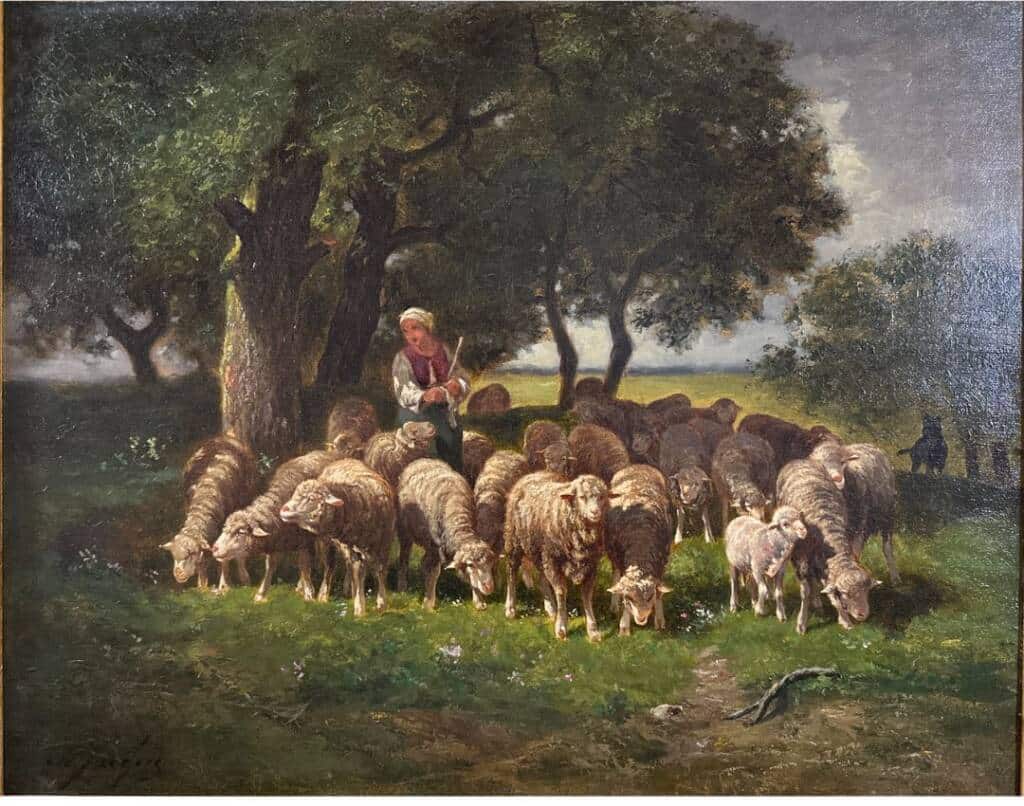
Charles Émile Jacque, a master of capturing pastoral scenes, transports viewers to idyllic landscapes in the Orient through his remarkable artworks. Known for his meticulous attention to detail, Jacque’s paintings evoke a sense of tranquility and immerse us in the beauty of rural life. One of his notable masterpieces, “Shepherdess And Her Flock” (21×26″), transports us to a world of golden landscapes and serene countryside.
In this captivating painting, Jacque skillfully depicts a shepherdess tending to her flock amidst a picturesque setting. The warm hues of the sun-kissed fields and the play of light and shadow create a sense of harmony and peacefulness. Every brushstroke reflects Jacque’s keen observation and deep appreciation for the natural world.
Through his artwork, Charles Émile Jacque invites us to pause and embrace the simplicity and beauty of rural life. His ability to capture the essence of the Orient’s pastoral landscapes allows us to experience a moment of respite and connect with the timeless rhythms of nature. “Shepherdess And Her Flock” is a testament to Jacque’s mastery of his craft and his ability to transport us to a world of serene beauty.
Exploring Jean-Leon Gerome’s ‘Along the Nile’ in Orientalist Art
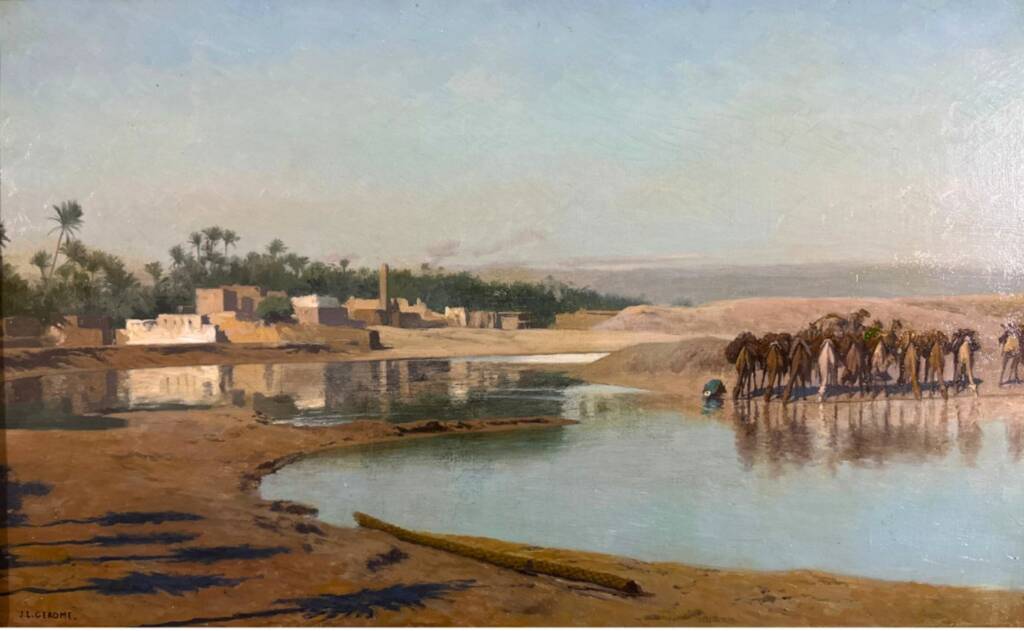
Jean-Leon Gerome, a master of Orientalist art, goes beyond technical brilliance to bring authenticity and cultural depth to his works. In his mesmerizing “Oil Painting on Canvas, 14×22” titled ‘Along the Nile,’ Gerome weaves together myth, legend, and rich cultural symbolism to create a captivating narrative that transports viewers to the enchanting landscapes of the Orient.
Through his extensive travels and deep immersion in Eastern cultures, Gerome gained firsthand knowledge and insights that are evident in his artwork. In ‘Along the Nile,’ he captures the essence of the river’s mystique and the vibrant life that thrived along its banks. With meticulous attention to detail and a keen eye for storytelling, Gerome transports us to a world where ancient legends come alive and where every stroke of his brush breathes life into his subjects.
This remarkable painting invites us to embark on a visual journey, delving into the layers of symbolism and myth that Gerome expertly incorporates. The rich colors, intricate textures, and evocative composition draw us into a narrative that speaks of the timeless allure of the Orient.
Jean-Leon Gerome’s ability to infuse his works with authenticity and cultural depth makes him a true master of Orientalist art. ‘Along the Nile’ stands as a testament to his artistic prowess and his unique ability to transport viewers to distant lands, where imagination intertwines with reality and captivates the senses.
Step into the world of Jean-Leon Gerome’s Orientalist masterpiece, ‘Along the Nile,’ and let its evocative beauty and narrative intrigue ignite your imagination and transport you to the enchanting landscapes of the Orient. Experience the magic of Gerome’s artistry as he takes you on a visual voyage, where myth, legend, and cultural symbolism intertwine to create a truly captivating artistic experience.
Exploring Charles Theodore Frere’s ‘Arab Encampment with a View of Jerusalem
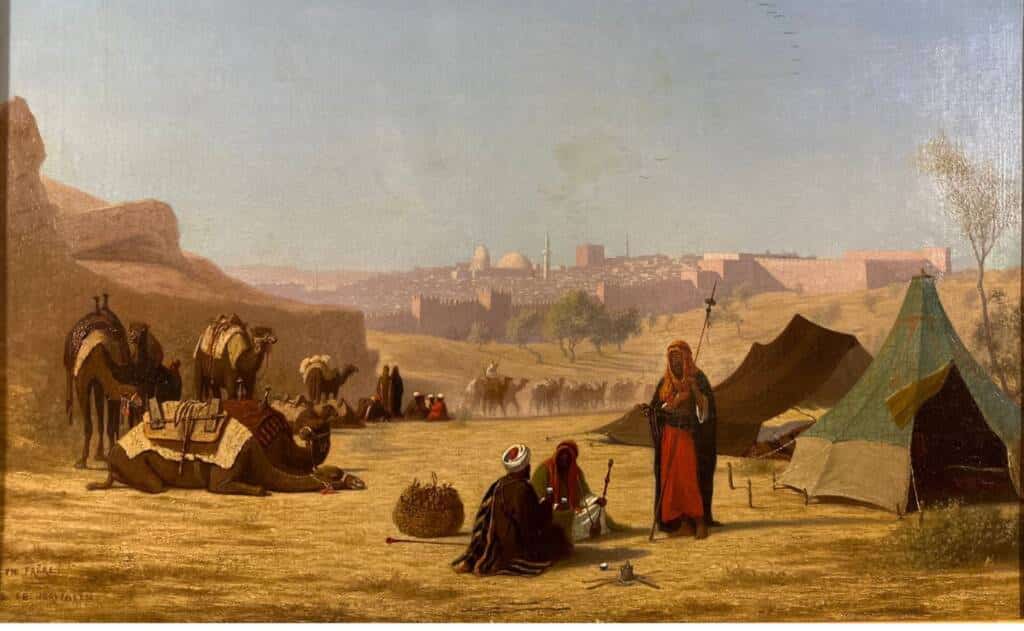
Step into the mesmerizing world of Charles Theodore Frere, where the Orient unfolds in all its splendor. Through his remarkable artwork, Frere transports viewers to captivating landscapes and historical landmarks. In his masterpiece, “Arab Encampment with a View of Jerusalem,” Frere captures the ethereal beauty of the desert and the majestic allure of one of the world’s most iconic cities.
With meticulous attention to detail and a keen understanding of light and architectural elements, Frere’s painting invites us to immerse ourselves in a scene that evokes a sense of awe and wonder. The golden hues of the desert, the intricate patterns of the encampment, and the distant silhouette of Jerusalem create a captivating composition that stirs the imagination.
Charles Theodore Frere’s ability to capture the essence of the Orient through his artwork is truly remarkable. His skillful portrayal of the desert landscape and his masterful rendering of architectural details transport us to a world where history, culture, and natural beauty converge.
As we gaze upon “Arab Encampment with a View of Jerusalem,” we are transported to a place where time stands still, and the allure of the Orient unfolds before our eyes. Charles Theodore Frere’s artistic vision invites us to appreciate the beauty and grandeur of the Orient in a way that leaves a lasting impression on our hearts and minds.
Arab Horsemen: Unleashing Power and Grace in Adolf Schreyer’s Captivating Equestrian Art

Adolf Schreyer, a renowned master of equestrian art, transports viewers into a world of exhilarating energy and mesmerizing beauty with his “Arab Horsemen” painting. This magnificent piece, an “Antique Oil Painting on Canvas” measuring 24″ x 12.75″, showcases Schreyer’s exceptional ability to capture the dynamic motion of horses against the backdrop of the Orient.
With each brushstroke, Schreyer infuses the canvas with a palpable sense of power, grace, and freedom. The galloping horses come alive, their muscular forms and flowing manes seemingly propelled by the desert winds. Set against the enchanting Oriental landscape, the painting evokes a sense of adventure and excitement, immersing viewers in a thrilling equestrian spectacle.
Schreyer’s attention to detail is exquisite, capturing the subtle nuances of horse anatomy and movement. Every stroke of the brush conveys a sense of vitality and energy, reflecting the deep connection between man and horse in Oriental cultures.
As you gaze upon “Arab Horsemen,” you’ll find yourself transported to a realm where the rhythmic hoofbeats and swirling dust of the desert create an atmosphere of exhilaration and awe. Schreyer’s masterful technique and profound understanding of equestrian art allow him to transport you to a world where the bond between man and horse is celebrated with unmatched intensity.
Immerse yourself in the captivating world of Adolf Schreyer’s equestrian art with “Arab Horsemen,” an “Antique Oil Painting on Canvas” (24″ x 12.75″). Let the power, grace, and vibrant energy of these magnificent creatures ignite your imagination and evoke a sense of wonder as you witness the timeless beauty of the Orient through the masterful strokes of Adolf Schreyer’s brush.
Unveiling the Oriental Splendor in Edwin Lord Weeks’ ‘Oil Painting Black & White on Canvas

Caravansary at Shiraz: Unveiling the Oriental Splendor in Edwin Lord Weeks’ ‘Oil Painting Black & White on Canvas'”
Edwin Lord Weeks, a master of capturing the interplay of light and shadow in Orientalist settings, takes us on a mesmerizing journey to the heart of the Orient with his renowned artwork, “Caravansary at Shiraz.” This captivating oil painting on board, measuring 15.50 x 18.50 inches, is a testament to Weeks’ artistic brilliance and his ability to transport viewers to a world of vibrant splendor.
As we gaze upon “Caravansary at Shiraz,” we are instantly transported to a bustling hub of trade and cultural exchange. Weeks’ meticulous attention to detail brings to life the intricate architecture of the caravansary, the busy activities of merchants and travelers, and the warm glow that bathes the scene in an ethereal light. The painting’s monochromatic palette adds a timeless quality, allowing us to focus on the rich textures and intricate patterns that define the Oriental landscape.
Weeks’ signature, a mark of his commitment to excellence, is a testament to the authenticity and mastery of his artwork. It serves as a reminder of the artist’s dedication to capturing the spirit and essence of the Orient.
In “Caravansary at Shiraz,” Edwin Lord Weeks invites us to embark on a visual odyssey through time and space. We are transported to an era of bustling caravansaries, where cultures converged, stories unfolded, and the allure of the Orient unfolded before our eyes. Weeks’ ability to capture the interplay of light, the architectural marvels, and the vibrant energy of the scene is truly remarkable, making this artwork a testament to his legacy as one of the great Orientalist artists of his time.
Experience the magic of Edwin Lord Weeks’ Orientalist art with his captivating masterpiece, “Caravansary at Shiraz.” Allow yourself to be immersed in the beauty, mystique, and cultural richness of the Orient as you explore this remarkable artwork, and let it transport you to a world where imagination and reality intertwine in a celebration of art and cultural heritage.
Evening Along the Nile: A Glimpse into Everyday Life in the Orient through Auguste Louis Veillon’s Masterpiece
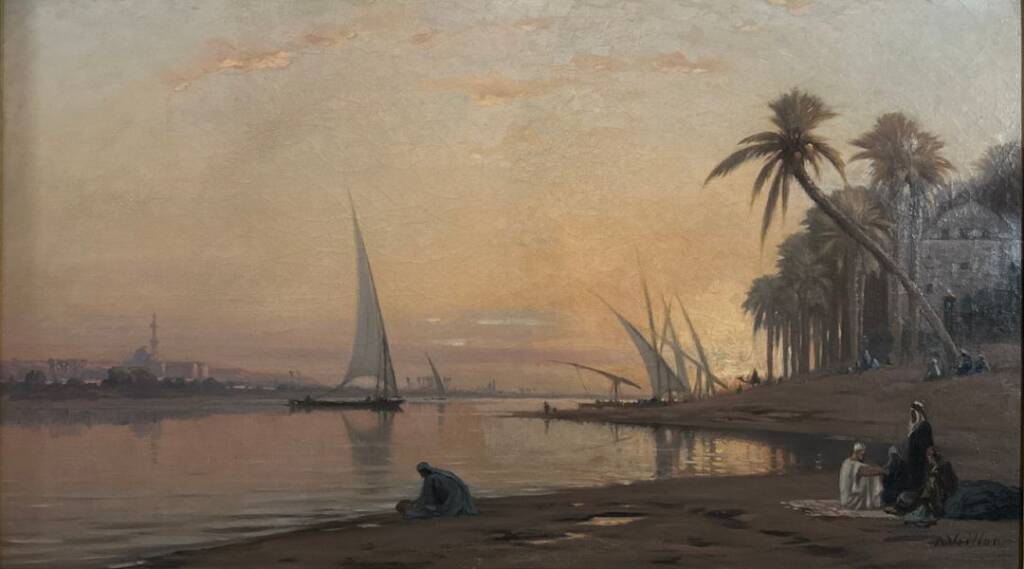
Auguste Louis Veillon’s masterpiece, titled “Evening Along the Nile,” unveils the captivating scenes of everyday life in the Orient. Through his impeccable artistry, Veillon invites us to immerse ourselves in the tranquility and beauty of an evening along the Nile River.
In this remarkable oil on panel painting, measuring 32 x 18.50 inches, Veillon skillfully captures the enchanting atmosphere of the Nile at dusk. The warm hues of the setting sun cast a gentle glow on the scene, illuminating the surrounding landscape and reflecting off the calm waters. The meticulous attention to detail and the artist’s signature bring authenticity and a sense of reverence to the artwork.
As we gaze upon “Evening Along the Nile,” we are transported to a world of serenity and contemplation. The painting depicts a moment of quiet reflection, where the everyday activities along the riverbank unfold in harmony with the timeless flow of the Nile. Veillon’s brushstrokes gracefully portray the figures and their gestures, capturing the essence of the scene and inviting us to become part of this serene moment.
“Evening Along the Nile” is a testament to Veillon’s ability to celebrate the beauty of ordinary moments. Through his masterful technique and deep appreciation for the Orient, Veillon brings to life the rich cultural heritage and everyday experiences that make this region so captivating.
Step into the world of Auguste Louis Veillon’s “Evening Along the Nile” and let yourself be captivated by the tranquility and beauty of the Orient. Experience the magic of an evening along the Nile, where time stands still, and the ordinary becomes extraordinary in the hands of a master artist.
Exploring the Musical Realm in Francesco Beda’s “Musical Interlude”
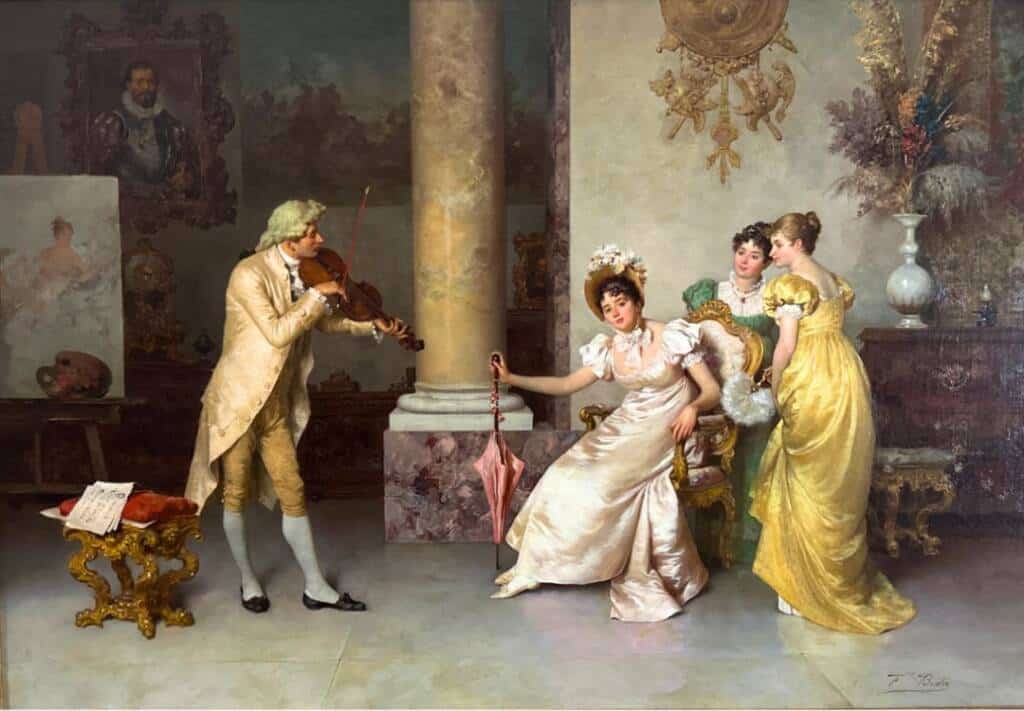
Francesco Beda, a masterful artist renowned for his ability to capture the essence of a scene, invites us into a realm of harmonious melodies with his extraordinary artwork, “Musical Interlude.” This captivating oil painting on canvas, measuring 24×36 inches, is a testament to Beda’s artistic brilliance and his talent for evoking emotions through his brushstrokes.
As we immerse ourselves in “Musical Interlude,” we are transported to a world where music becomes a language of its own. Beda’s meticulous attention to detail breathes life into the musicians and their instruments, capturing the rhythm and passion that flows through their movements. The interplay of light and shadow creates a mesmerizing atmosphere, casting a soft glow that envelops the scene and heightens the sense of intimacy.
Beda’s mastery of composition and color palette allows us to appreciate the rich textures and intricate details that define the musical landscape. The vibrant hues evoke the emotions conveyed through the music, and each brushstroke carries a note of its own, resonating with the viewer’s imagination. Through his skillful rendering, Beda invites us to become part of the musical experience, transcending the boundaries of time and space.
The artist’s signature, a mark of his dedication to his craft, serves as a reminder of Beda’s commitment to capturing the spirit of the moment. It symbolizes his passion for translating the universal language of music into a visual form, inviting us to witness the beauty and power of artistic expression.
In “Musical Interlude,” Francesco Beda invites us to join a symphony of emotions, where the melodies transcend words and touch the depths of our souls. Through his profound understanding of light, composition, and human connection, Beda creates an immersive experience that resonates with the viewer on a profound level. His artwork stands as a testament to his legacy as a gifted artist, and his ability to capture the intangible beauty of music.
Experience the enchantment of Francesco Beda’s artistic vision with his captivating masterpiece, “Musical Interlude.” Allow yourself to be transported to a world where music becomes visual poetry, where the harmonies and rhythms intertwine, and where art and music merge into an unforgettable celebration of the human spirit. Let Beda’s artwork inspire you to explore the limitless boundaries of creativity and embrace the transformative power of art and music.


